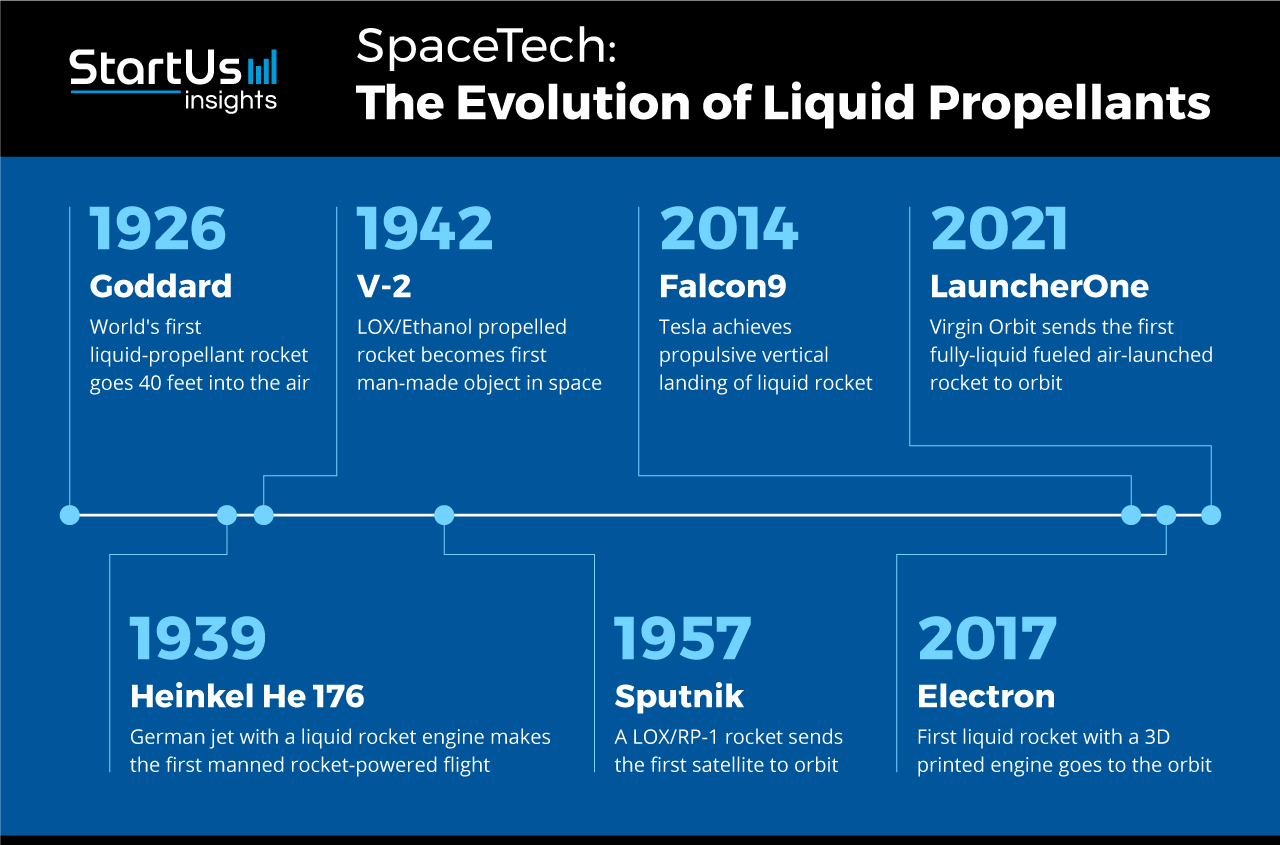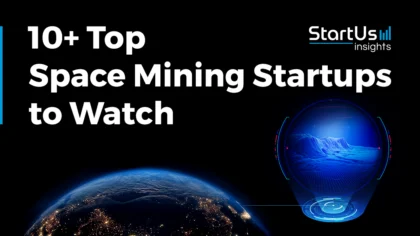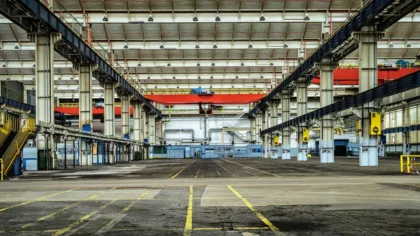Accelerate Productivity in 2025
Reignite Growth Despite the Global Slowdown
LauncherOne, a Virgin Orbit rocket, deployed 10 CubeSats in orbit on January 17th, 2021. Launched from a Boeing 747 airplane, it was the first fully-liquid fuelled air-launched rocket to reach orbit. While most ground-launched rockets are also liquid-fuelled, this development demonstrates that liquid propulsion has a lot more to offer. And we are going to explore these opportunities in this data-driven report. The report leverages the Big Data & Artificial Intelligence (AI)-powered StartUs Insights Discovery Platform, covering over 1.3 million startups & scaleups globally, providing you with data-driven insights into startups that develop liquid propellants, their geographical distribution, as well as funding activity in the field.
The Challenge of Propulsion in SpaceTech
2020 was a breakout year for the SpaceTech industry. In the first-ever commercial crewed launch, SpaceX’s Crew Dragon spacecraft took two astronauts to the International Space Station. More satellites were launched into space in 2020 than any year before. Hayabusa 2, an asteroid sampling mission from the Japanese space agency JAXA, returned with samples from the asteroid Ryugu. Two rovers – NASA’s Mars 2020 and the China National Space Administration’s (CNSA) Mars 2020 mission – set off for Mars where they will be collecting samples. Perseverance, NASA’s Mars 2020 rover, landed on Mars on February 18th, 2021. The NASA mission will also be testing equipment that may find use in manned Mars missions in the future.
However, future missions need to address a major double-bind. Sending heavier payloads to farther distances requires larger amounts of propellant which, in turn, contributes to the weight. In fact, the propellant often comprises up to 85% of a rocket’s weight. Before launching in-space or deep-space missions, the SpaceTech industry needs to develop technologies to make escape propulsion more efficient. One solution is liquid-propellant rockets that currently perform better than solid-propellant rockets, making them the choice for most orbital launch vehicles.
The mass of a rocket includes the propellant, payload, and vehicle. Liquid-propellant rockets have a higher propellant mass fraction which translates into a more efficient design. Any reduction in vehicle mass due to an efficient rocket design is available for the payload. Making them even more efficient is a challenge that needs rapid developments in both propellants and rocket design.
What makes Liquid Propellants special?
Liquid-propellant engines have many benefits over solid-propellant engines. In liquid rockets, the two components of a propellant – fuel and the oxidizer – are in separate tanks. Many oxidizers such as liquid oxygen and hydrogen peroxide have a higher specific impulse than solid propellants. This means liquid-propelled rockets are more efficient in using up the propellant. Some of them are throttleable, allowing real-time variation in thrust. When designed with a supporting ignition system, they can also be shut down and restarted in space.
The disadvantages of liquid propellants also stem from the oxidizers in use. The requirement for two separate tanks and the pumps and piping adds to the complexity of the design, as well as the rocket mass. Moreover, some liquid propellants such as nitric oxide are toxic and reactive, while cryogenic propellants need low temperatures.
Global Startup Heat Map reveals where Liquid Propellants are developed
As a company with a mission to map the world’s information on innovations, emerging companies, and technologies, we routinely look into emerging solutions that impact businesses globally. To discover innovative liquid propellant solutions, we used the StartUs Insights Discovery Platform to identify SpaceTech startups and scaleups that work on liquid propellant technologies. You get to discover some of the startups we hand-picked for this research below.
We also looked at the global geographic distribution of 89 global startups & scaleups developing liquid propellants. The Global Startup Heat Map below gives you a clear picture of where the major hubs are, as well as up-and-coming regions that show significant activity. SpaceTech startups working on liquid propellants are primarily concentrated in California and the UK.
$18M average Funding for Liquid Propellants
The last decade witnessed a renewed interest in the SpaceTech sector with a rapid rise in the number of startups globally. Traditionally largely dominated by national space engines, billionaires like Jeff Bezos (BlueOrigin) and Richard Branson (Virgin Orbit) recently also jumped into the game, in large part due to Elon Musk’s success with SpaceX. Additionally, Venture Capital (VC) firms like Voyager Space Holdings and Space Capital are heavily investing in the industry. Among startups founded in 2015 or later, startups and scaleups working on liquid propellants raised on average $18M in funding.
How Liquid Propellants are fuelling Innovation in SpaceTech
There is an upsurge in startups launching minisatellites and nanosatellites for applications in agriculture, the Internet of Things (IoT), and energy, to name a few areas. Consequently, there is a rise in the startups that develop launch vehicles and rockets to put these satellites in orbit. SpaceTech startups are innovating to meet the needs of this new clientele while improving the efficiency and sustainability of liquid propulsion.
Launcher develops Rocket for Small Satellites
The US-based startup Launcher develops a rocket to deliver small satellites to orbit. Launcher Rocket-1 has a payload capacity of 773 kg and 400 kg for delivery to 200 km orbit and 500 km sun-synchronous orbit (SSO), respectively. It uses liquid oxygen (LOX) and kerosene (RP-1) as the propellant. The rocket’s design features a closed cycle for oxidizer-rich staged combustion and 3D-printed copper alloy as the combustion chamber material.
LandSpace manufactures Small and Medium Launch Vehicles
Chinese startup LandSpace manufactures small and medium launch vehicles. The startup’s launch vehicles ZQ-1 and ZQ-2 deliver 200 kg and 1.800 kg of payloads, respectively, to 500 km SSO. The Tian Que (TQ) Liquid Rocket Engine uses liquid oxygen and liquid methane (LCH4) as the propellant. By reducing harmful exhaust with liquid methane, the startup’s solution is a relatively eco-friendly alternative to conventional liquid propulsion.
Phoenix Launch Systems offers a Hypergolic Propellant
Phoenix Launch Systems is a US-based startup serving nanosatellite companies. The startup’s advanced reusable nano-launcher carries up to 22 kg of payload to low-earth orbit (LEO). It uses a hydrogen peroxide-based hypergolic propellant that does not need a separate ignition system. Moreover, the propellant is non-toxic, non-carcinogenic, and produces eco-friendly exhaust.
AgniKul creates a Semi-cryogenic Engine
Indian startup AgniKul creates Agnilet, a single piece, 3D printed, engine. The semi-cryogenic is fully liquid-fuelled, burning LOX/RP-1. Agnibaan, the startup’s customizable satellite launch vehicle, delivers 100 kg of payload to 700 km LEO. The startup also offers Dhanush, a mobile launch pedestal that enables repeated and consistent launches from anywhere.
Skyrora upcycles Plastic Waste into high-grade Kerosene
British startup Skyrora develops Ecosene, high-grade kerosene for aerospace. Skyrora’s plastic recycling process uses catalytic pyrolysis to convert polypropylenes, polyesters, and polystyrenes into kerosene. The startup’s Skyrora XL orbital launch vehicle and Skyrora L suborbital launch vehicle use a combination of kerosene and high-test peroxide (HTP) as the propellant. The two launch vehicles carry payloads up to 315 kg and 50 kg, respectively.
Making Liquid Rockets more efficient and sustainable
Oxygen, a common oxidizer in liquid propellants, is abundant in the atmosphere. This prompts space organizations such as NASA and ESA as well as startups to work on solutions that tap this oxygen. Air-breathing rockets, currently under development, use oxygen from the air during the atmospheric part of the flight. This development allows for carrying higher payloads as well as the introduction of rocket features, such as wings or thermal-protection systems, that improve reusability.
In the more immediate future, there is an increased push for green and electric propulsion systems to lower the carbon footprint of the SpaceTech sector. Therefore, startups are working on hybrid propellants that combine the best of both solid and liquid propulsion. They provide high take-off thrust, reliability, and robustness like the solid propellants, while allowing combustion to be stopped, varied, or restarted like the liquid propellants. Additionally, advances in additive manufacturing are addressing the design complexity of liquid rockets.
Propel your business with data-driven Innovation Insights
This data-driven report scratches only the surface of the depth and breadth of solutions SpaceTech startups are working on. To learn more, you can explore our curated report on emerging SpaceTech industry trends & technologies or let us do the work for you. Regardless of your industry and the solutions you are looking for, we provide you data-driven insights into new startups, scaleups, and emerging technologies to propel your business and ensure that you stay ahead of the technology curve.









